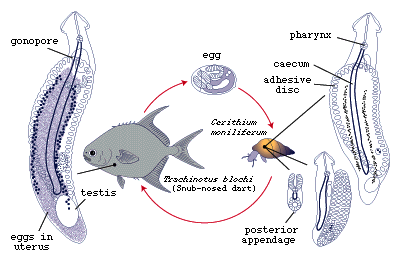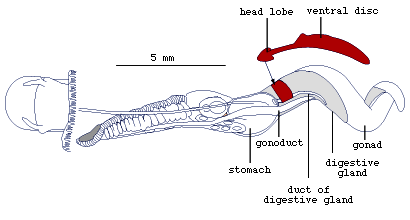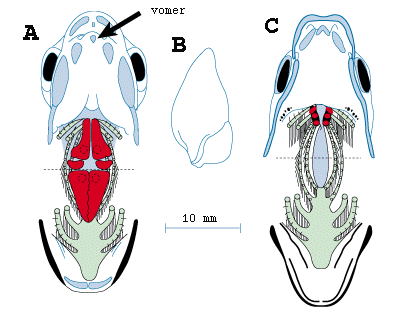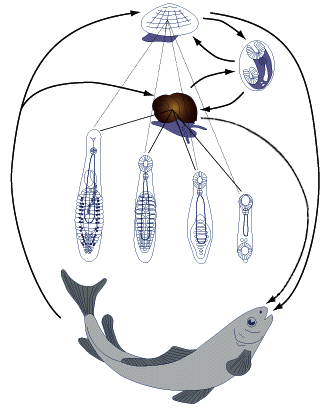The life cycles of several species are known, although most of them incompletely. Life cycles of Stichocotylida have not been studied, although larvae of Stichocotyle nephropis were found encapsulated in marine decapod crustaceans. All life cycles studied to date involve a mollusc (snail or bivalve) and a vertebrate host. The vertebrate is an obligate host, i.e., maturation occurs after ingestion of molluscs containing juvenile aspidogastreans, or it is a facultative host , i.e., maturation may occur in the mollusc. I discuss one example of each type of life cycle.
Lobatostoma manteri


Figure 1. Life cycle of Lobatostoma manteri.
Lobatostoma manteri is an example of a species which has obligate vertebrate hosts (Fig. 1). Adult worms live in the small intestine of the snubnosed dart, Trachinotus blochi (Teleostei, Carangidae), on the Great Barrier Reef. They produce large numbers of eggs which are shed in the faeces. If eaten by various prosobranch snails, larvae hatch in the stomach, and - depending on the species of snail - stay there or migrate to the digestive gland where they grow up to the preadult stage which has all the characteristics of the adult including a testis and ovary (Fig. 2) (Rohde, 1973).


Figure 2. Juvenile Lobatostoma manteri (red) in the digestive gland of the snail Cerithium (Clypeomorus) moniliferum (redrawn from Rohde, 1973).
However, it does not produce eggs. Fish become infected by eating infected snails, which are crushed between the very strong pharyngeal plates (Fig. 3).


Figure 3. Heads of two small carangid fishes, Trachinotus blochi (A) and Caranx melampygus. (C).Pharyngeal plates are drawn red. Only T. blochi can crush snails between its dorsal and ventral pharyngeal plates and become infected with Lobatostoma manteri. The most common intermediate host, Cerithium moniliferum (B) fits exactly into the mouth, it is prevented from slipping out of the mouth by the dorsal vomer (arrow) (redrawn from Rohde, 1973).
At Heron Island, where the life cycle was worked out, three species of snails were found to be infected naturally, i.e., Cerithium (Clypeomorus) moniliferum, Planaxis sulcatus, and Peristernia australiensis. Observations over several years showed that worms did not mature in any of them.
Aspidogaster conchicola


Figure 4. Life cycle of Aspidogaster conchicola.
Aspidogaster conchicola is an example of a species which has a facultative vertebrate host. Adult worms live in a large range of freshwater snails, bivalves, teleost fish and turtles. There are contradictory reports on how molluscs become infected, either by eggs containing infective larvae or by larvae after hatching. Vertebrates become infected by eating infected molluscs (Rohde, 1972, other references therein).




 Go to quick links
Go to quick search
Go to navigation for this section of the ToL site
Go to detailed links for the ToL site
Go to quick links
Go to quick search
Go to navigation for this section of the ToL site
Go to detailed links for the ToL site